Comprehensive Risk and Disaster Management for NASA's ISS Project
VerifiedAdded on 2020/02/05
|11
|2870
|485
Report
AI Summary
This report provides an executive summary of a risk assessment conducted for NASA's International Space Station (ISS) project. It begins with an overview of NASA and the ISS project, followed by an identification of potential risks, including operational, financial, strategic, and technological challenges. The report outlines risk and disaster management plans, emphasizing the importance of identifying and mitigating risks through proactive measures like listing potential risks, determining responsible areas, monitoring risks, and planning responses. The report also evaluates qualitative and quantitative risk assessment methods, highlighting the strengths and weaknesses of each approach. The conclusion recommends that NASA regularly evaluate its business processes, focus on objectives, and develop robust management plans to minimize risks and ensure the smooth functioning of the ISS project. The report underscores the importance of these plans in reducing uncertainties and negative impacts on the business environment. The report emphasizes the need for a proactive approach to managing risks in the context of aerospace projects, including natural and artificial disasters.
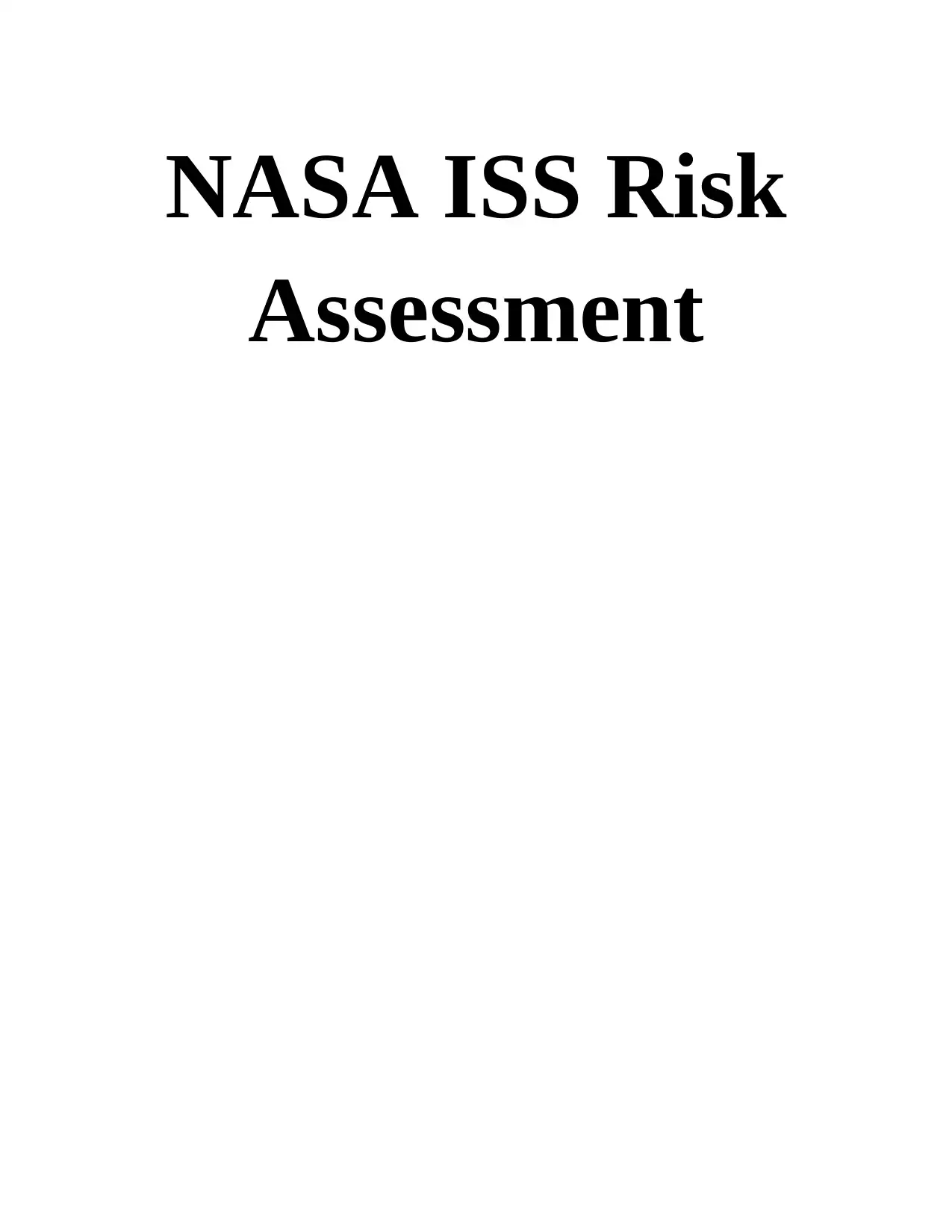
NASA ISS Risk
Assessment
Assessment
Paraphrase This Document
Need a fresh take? Get an instant paraphrase of this document with our AI Paraphraser
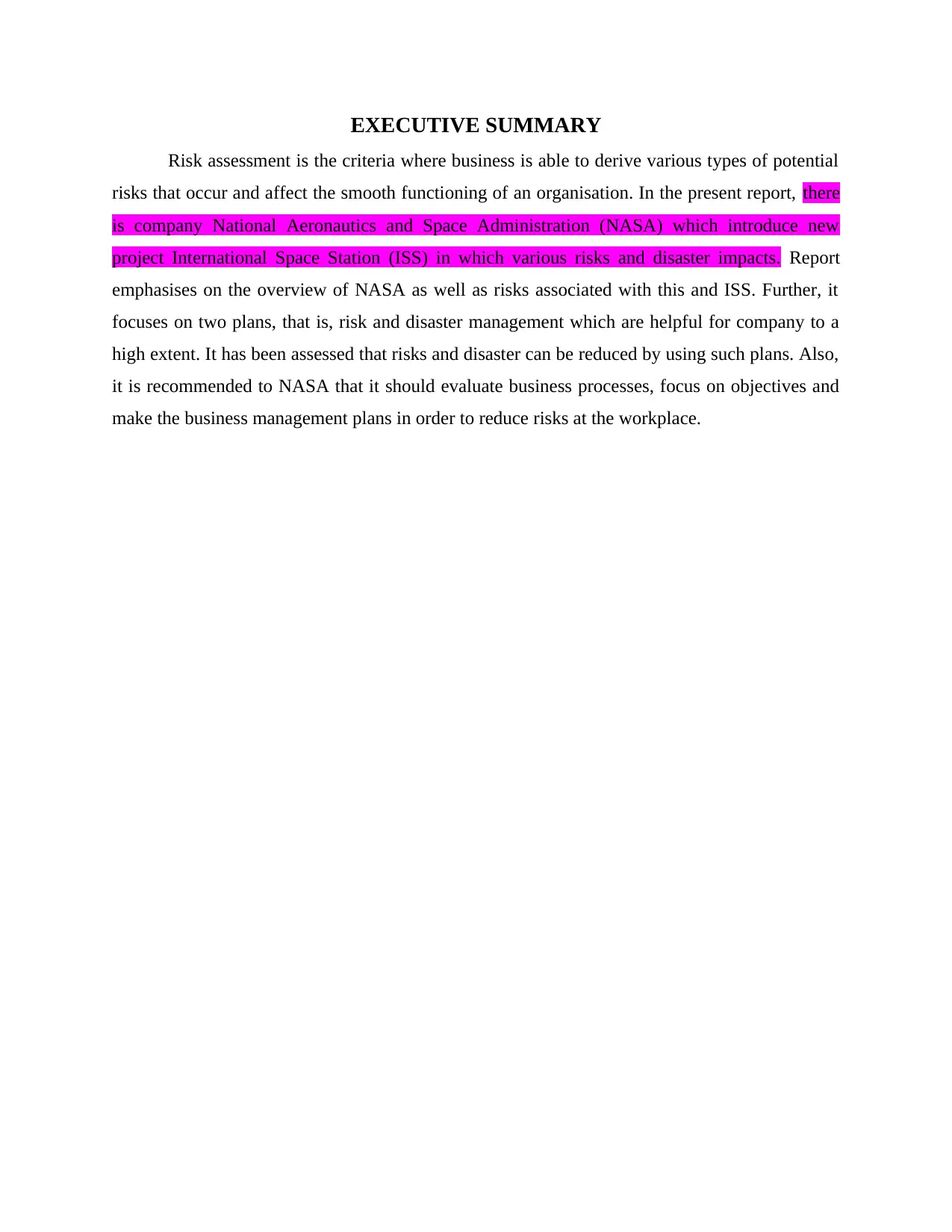
EXECUTIVE SUMMARY
Risk assessment is the criteria where business is able to derive various types of potential
risks that occur and affect the smooth functioning of an organisation. In the present report, there
is company National Aeronautics and Space Administration (NASA) which introduce new
project International Space Station (ISS) in which various risks and disaster impacts. Report
emphasises on the overview of NASA as well as risks associated with this and ISS. Further, it
focuses on two plans, that is, risk and disaster management which are helpful for company to a
high extent. It has been assessed that risks and disaster can be reduced by using such plans. Also,
it is recommended to NASA that it should evaluate business processes, focus on objectives and
make the business management plans in order to reduce risks at the workplace.
Risk assessment is the criteria where business is able to derive various types of potential
risks that occur and affect the smooth functioning of an organisation. In the present report, there
is company National Aeronautics and Space Administration (NASA) which introduce new
project International Space Station (ISS) in which various risks and disaster impacts. Report
emphasises on the overview of NASA as well as risks associated with this and ISS. Further, it
focuses on two plans, that is, risk and disaster management which are helpful for company to a
high extent. It has been assessed that risks and disaster can be reduced by using such plans. Also,
it is recommended to NASA that it should evaluate business processes, focus on objectives and
make the business management plans in order to reduce risks at the workplace.
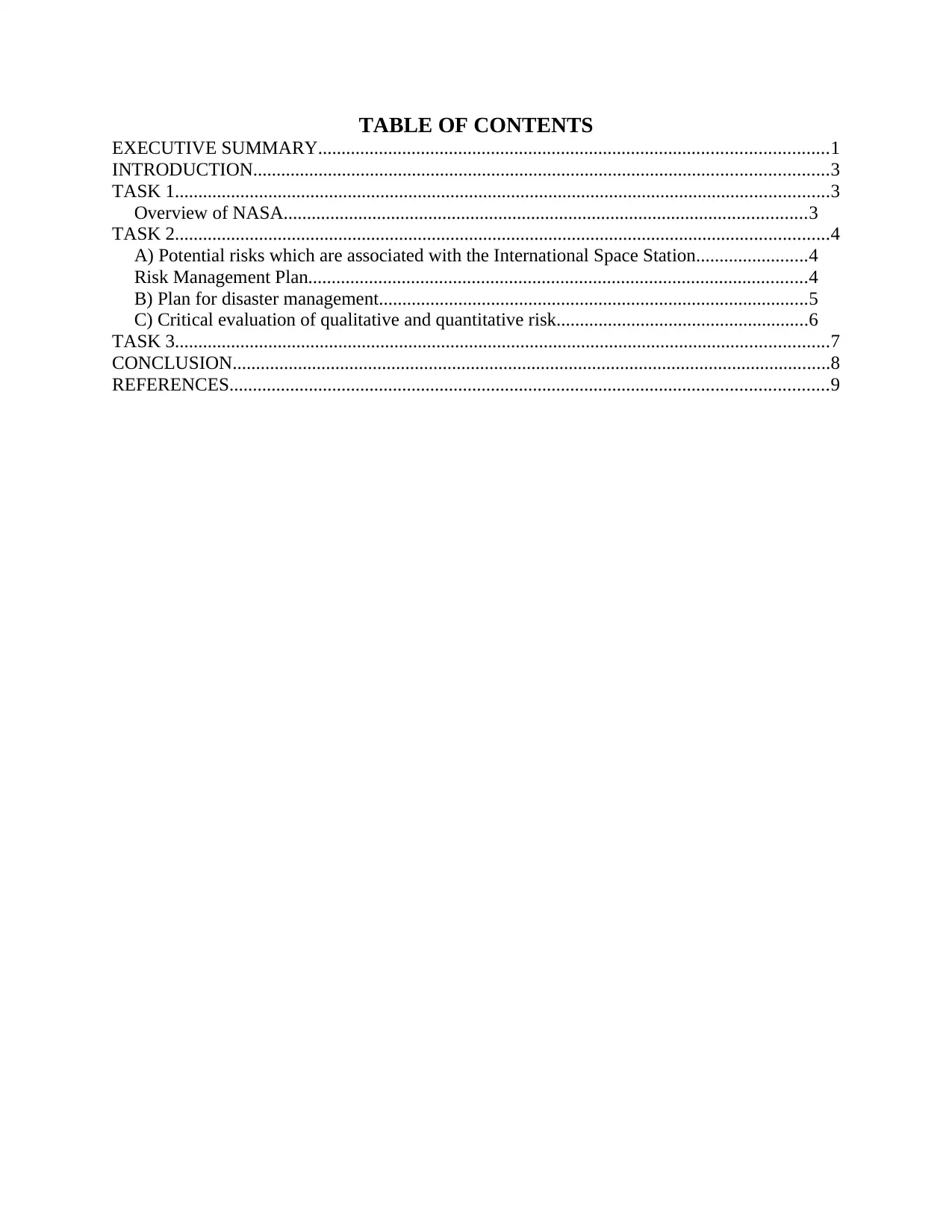
TABLE OF CONTENTS
EXECUTIVE SUMMARY.............................................................................................................1
INTRODUCTION...........................................................................................................................3
TASK 1............................................................................................................................................3
Overview of NASA................................................................................................................3
TASK 2............................................................................................................................................4
A) Potential risks which are associated with the International Space Station........................4
Risk Management Plan...........................................................................................................4
B) Plan for disaster management............................................................................................5
C) Critical evaluation of qualitative and quantitative risk......................................................6
TASK 3............................................................................................................................................7
CONCLUSION................................................................................................................................8
REFERENCES................................................................................................................................9
EXECUTIVE SUMMARY.............................................................................................................1
INTRODUCTION...........................................................................................................................3
TASK 1............................................................................................................................................3
Overview of NASA................................................................................................................3
TASK 2............................................................................................................................................4
A) Potential risks which are associated with the International Space Station........................4
Risk Management Plan...........................................................................................................4
B) Plan for disaster management............................................................................................5
C) Critical evaluation of qualitative and quantitative risk......................................................6
TASK 3............................................................................................................................................7
CONCLUSION................................................................................................................................8
REFERENCES................................................................................................................................9
⊘ This is a preview!⊘
Do you want full access?
Subscribe today to unlock all pages.

Trusted by 1+ million students worldwide
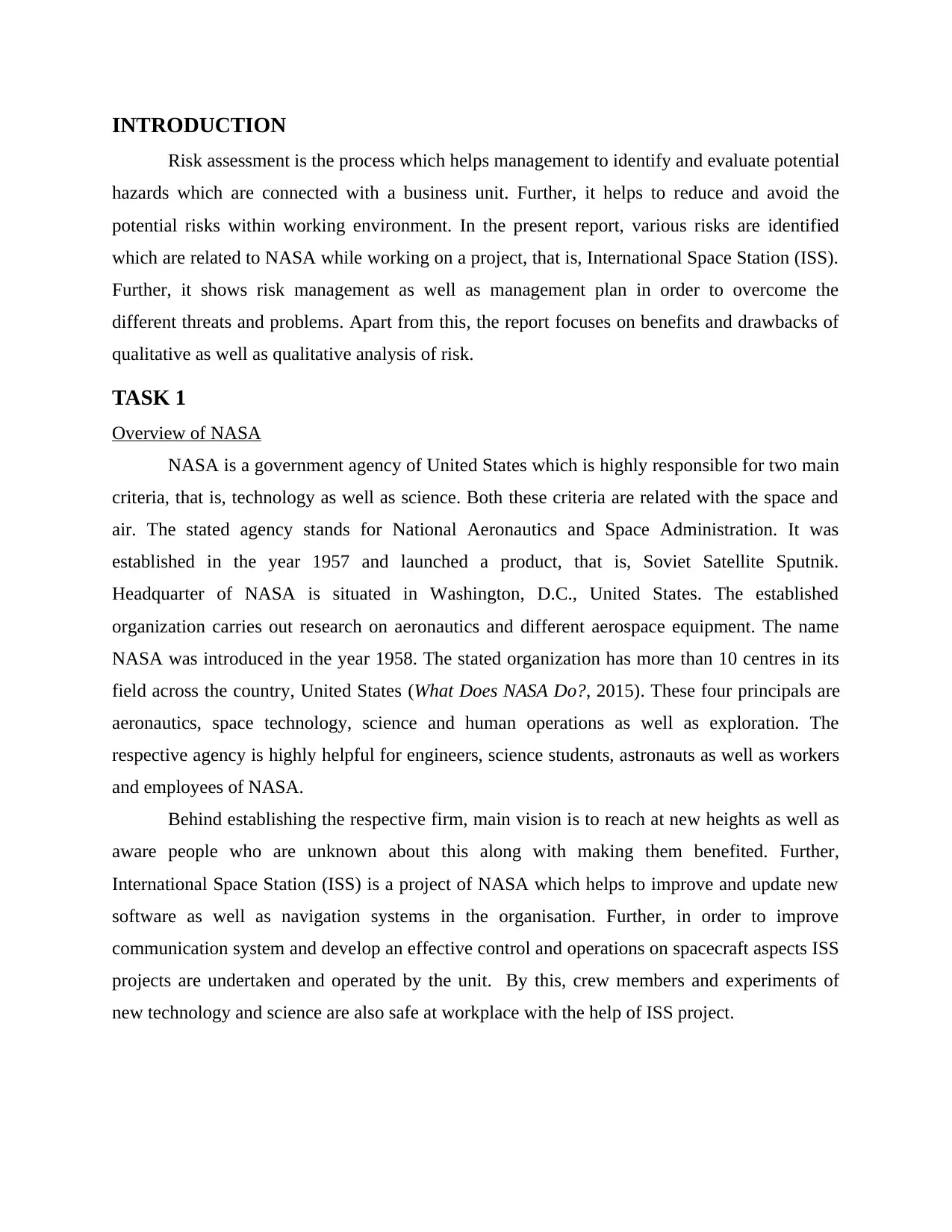
INTRODUCTION
Risk assessment is the process which helps management to identify and evaluate potential
hazards which are connected with a business unit. Further, it helps to reduce and avoid the
potential risks within working environment. In the present report, various risks are identified
which are related to NASA while working on a project, that is, International Space Station (ISS).
Further, it shows risk management as well as management plan in order to overcome the
different threats and problems. Apart from this, the report focuses on benefits and drawbacks of
qualitative as well as qualitative analysis of risk.
TASK 1
Overview of NASA
NASA is a government agency of United States which is highly responsible for two main
criteria, that is, technology as well as science. Both these criteria are related with the space and
air. The stated agency stands for National Aeronautics and Space Administration. It was
established in the year 1957 and launched a product, that is, Soviet Satellite Sputnik.
Headquarter of NASA is situated in Washington, D.C., United States. The established
organization carries out research on aeronautics and different aerospace equipment. The name
NASA was introduced in the year 1958. The stated organization has more than 10 centres in its
field across the country, United States (What Does NASA Do?, 2015). These four principals are
aeronautics, space technology, science and human operations as well as exploration. The
respective agency is highly helpful for engineers, science students, astronauts as well as workers
and employees of NASA.
Behind establishing the respective firm, main vision is to reach at new heights as well as
aware people who are unknown about this along with making them benefited. Further,
International Space Station (ISS) is a project of NASA which helps to improve and update new
software as well as navigation systems in the organisation. Further, in order to improve
communication system and develop an effective control and operations on spacecraft aspects ISS
projects are undertaken and operated by the unit. By this, crew members and experiments of
new technology and science are also safe at workplace with the help of ISS project.
Risk assessment is the process which helps management to identify and evaluate potential
hazards which are connected with a business unit. Further, it helps to reduce and avoid the
potential risks within working environment. In the present report, various risks are identified
which are related to NASA while working on a project, that is, International Space Station (ISS).
Further, it shows risk management as well as management plan in order to overcome the
different threats and problems. Apart from this, the report focuses on benefits and drawbacks of
qualitative as well as qualitative analysis of risk.
TASK 1
Overview of NASA
NASA is a government agency of United States which is highly responsible for two main
criteria, that is, technology as well as science. Both these criteria are related with the space and
air. The stated agency stands for National Aeronautics and Space Administration. It was
established in the year 1957 and launched a product, that is, Soviet Satellite Sputnik.
Headquarter of NASA is situated in Washington, D.C., United States. The established
organization carries out research on aeronautics and different aerospace equipment. The name
NASA was introduced in the year 1958. The stated organization has more than 10 centres in its
field across the country, United States (What Does NASA Do?, 2015). These four principals are
aeronautics, space technology, science and human operations as well as exploration. The
respective agency is highly helpful for engineers, science students, astronauts as well as workers
and employees of NASA.
Behind establishing the respective firm, main vision is to reach at new heights as well as
aware people who are unknown about this along with making them benefited. Further,
International Space Station (ISS) is a project of NASA which helps to improve and update new
software as well as navigation systems in the organisation. Further, in order to improve
communication system and develop an effective control and operations on spacecraft aspects ISS
projects are undertaken and operated by the unit. By this, crew members and experiments of
new technology and science are also safe at workplace with the help of ISS project.
Paraphrase This Document
Need a fresh take? Get an instant paraphrase of this document with our AI Paraphraser
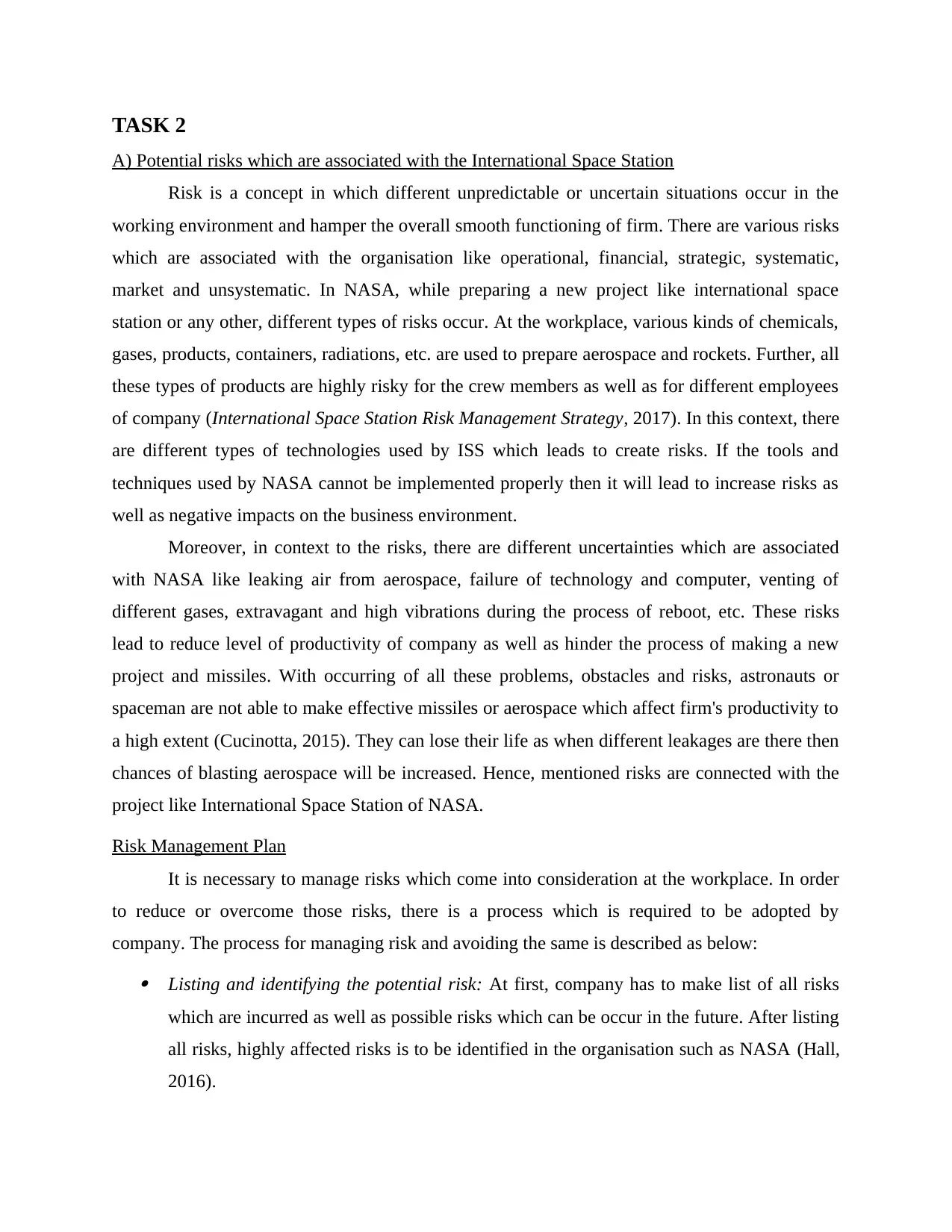
TASK 2
A) Potential risks which are associated with the International Space Station
Risk is a concept in which different unpredictable or uncertain situations occur in the
working environment and hamper the overall smooth functioning of firm. There are various risks
which are associated with the organisation like operational, financial, strategic, systematic,
market and unsystematic. In NASA, while preparing a new project like international space
station or any other, different types of risks occur. At the workplace, various kinds of chemicals,
gases, products, containers, radiations, etc. are used to prepare aerospace and rockets. Further, all
these types of products are highly risky for the crew members as well as for different employees
of company (International Space Station Risk Management Strategy, 2017). In this context, there
are different types of technologies used by ISS which leads to create risks. If the tools and
techniques used by NASA cannot be implemented properly then it will lead to increase risks as
well as negative impacts on the business environment.
Moreover, in context to the risks, there are different uncertainties which are associated
with NASA like leaking air from aerospace, failure of technology and computer, venting of
different gases, extravagant and high vibrations during the process of reboot, etc. These risks
lead to reduce level of productivity of company as well as hinder the process of making a new
project and missiles. With occurring of all these problems, obstacles and risks, astronauts or
spaceman are not able to make effective missiles or aerospace which affect firm's productivity to
a high extent (Cucinotta, 2015). They can lose their life as when different leakages are there then
chances of blasting aerospace will be increased. Hence, mentioned risks are connected with the
project like International Space Station of NASA.
Risk Management Plan
It is necessary to manage risks which come into consideration at the workplace. In order
to reduce or overcome those risks, there is a process which is required to be adopted by
company. The process for managing risk and avoiding the same is described as below: Listing and identifying the potential risk: At first, company has to make list of all risks
which are incurred as well as possible risks which can be occur in the future. After listing
all risks, highly affected risks is to be identified in the organisation such as NASA (Hall,
2016).
A) Potential risks which are associated with the International Space Station
Risk is a concept in which different unpredictable or uncertain situations occur in the
working environment and hamper the overall smooth functioning of firm. There are various risks
which are associated with the organisation like operational, financial, strategic, systematic,
market and unsystematic. In NASA, while preparing a new project like international space
station or any other, different types of risks occur. At the workplace, various kinds of chemicals,
gases, products, containers, radiations, etc. are used to prepare aerospace and rockets. Further, all
these types of products are highly risky for the crew members as well as for different employees
of company (International Space Station Risk Management Strategy, 2017). In this context, there
are different types of technologies used by ISS which leads to create risks. If the tools and
techniques used by NASA cannot be implemented properly then it will lead to increase risks as
well as negative impacts on the business environment.
Moreover, in context to the risks, there are different uncertainties which are associated
with NASA like leaking air from aerospace, failure of technology and computer, venting of
different gases, extravagant and high vibrations during the process of reboot, etc. These risks
lead to reduce level of productivity of company as well as hinder the process of making a new
project and missiles. With occurring of all these problems, obstacles and risks, astronauts or
spaceman are not able to make effective missiles or aerospace which affect firm's productivity to
a high extent (Cucinotta, 2015). They can lose their life as when different leakages are there then
chances of blasting aerospace will be increased. Hence, mentioned risks are connected with the
project like International Space Station of NASA.
Risk Management Plan
It is necessary to manage risks which come into consideration at the workplace. In order
to reduce or overcome those risks, there is a process which is required to be adopted by
company. The process for managing risk and avoiding the same is described as below: Listing and identifying the potential risk: At first, company has to make list of all risks
which are incurred as well as possible risks which can be occur in the future. After listing
all risks, highly affected risks is to be identified in the organisation such as NASA (Hall,
2016).
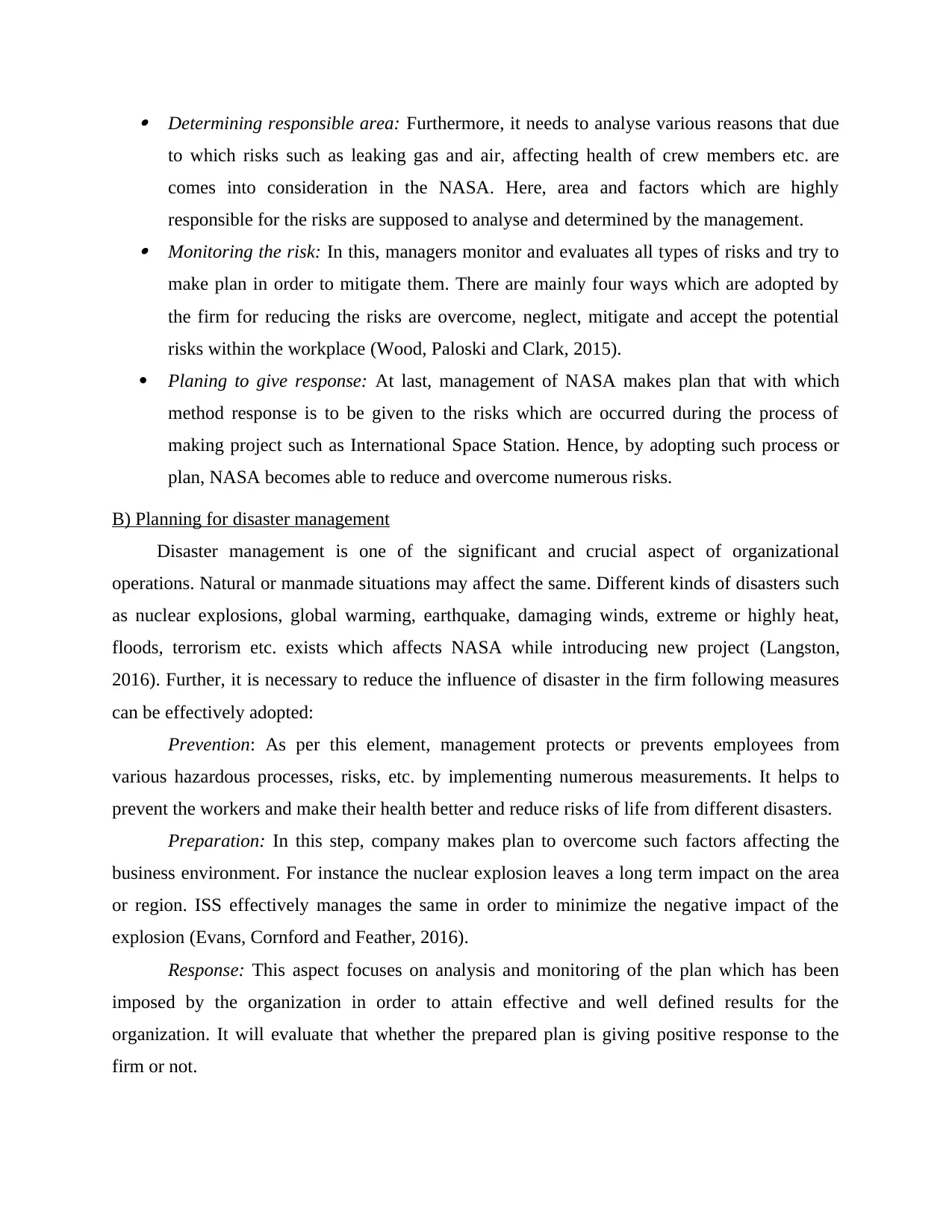
Determining responsible area: Furthermore, it needs to analyse various reasons that due
to which risks such as leaking gas and air, affecting health of crew members etc. are
comes into consideration in the NASA. Here, area and factors which are highly
responsible for the risks are supposed to analyse and determined by the management. Monitoring the risk: In this, managers monitor and evaluates all types of risks and try to
make plan in order to mitigate them. There are mainly four ways which are adopted by
the firm for reducing the risks are overcome, neglect, mitigate and accept the potential
risks within the workplace (Wood, Paloski and Clark, 2015).
Planing to give response: At last, management of NASA makes plan that with which
method response is to be given to the risks which are occurred during the process of
making project such as International Space Station. Hence, by adopting such process or
plan, NASA becomes able to reduce and overcome numerous risks.
B) Planning for disaster management
Disaster management is one of the significant and crucial aspect of organizational
operations. Natural or manmade situations may affect the same. Different kinds of disasters such
as nuclear explosions, global warming, earthquake, damaging winds, extreme or highly heat,
floods, terrorism etc. exists which affects NASA while introducing new project (Langston,
2016). Further, it is necessary to reduce the influence of disaster in the firm following measures
can be effectively adopted:
Prevention: As per this element, management protects or prevents employees from
various hazardous processes, risks, etc. by implementing numerous measurements. It helps to
prevent the workers and make their health better and reduce risks of life from different disasters.
Preparation: In this step, company makes plan to overcome such factors affecting the
business environment. For instance the nuclear explosion leaves a long term impact on the area
or region. ISS effectively manages the same in order to minimize the negative impact of the
explosion (Evans, Cornford and Feather, 2016).
Response: This aspect focuses on analysis and monitoring of the plan which has been
imposed by the organization in order to attain effective and well defined results for the
organization. It will evaluate that whether the prepared plan is giving positive response to the
firm or not.
to which risks such as leaking gas and air, affecting health of crew members etc. are
comes into consideration in the NASA. Here, area and factors which are highly
responsible for the risks are supposed to analyse and determined by the management. Monitoring the risk: In this, managers monitor and evaluates all types of risks and try to
make plan in order to mitigate them. There are mainly four ways which are adopted by
the firm for reducing the risks are overcome, neglect, mitigate and accept the potential
risks within the workplace (Wood, Paloski and Clark, 2015).
Planing to give response: At last, management of NASA makes plan that with which
method response is to be given to the risks which are occurred during the process of
making project such as International Space Station. Hence, by adopting such process or
plan, NASA becomes able to reduce and overcome numerous risks.
B) Planning for disaster management
Disaster management is one of the significant and crucial aspect of organizational
operations. Natural or manmade situations may affect the same. Different kinds of disasters such
as nuclear explosions, global warming, earthquake, damaging winds, extreme or highly heat,
floods, terrorism etc. exists which affects NASA while introducing new project (Langston,
2016). Further, it is necessary to reduce the influence of disaster in the firm following measures
can be effectively adopted:
Prevention: As per this element, management protects or prevents employees from
various hazardous processes, risks, etc. by implementing numerous measurements. It helps to
prevent the workers and make their health better and reduce risks of life from different disasters.
Preparation: In this step, company makes plan to overcome such factors affecting the
business environment. For instance the nuclear explosion leaves a long term impact on the area
or region. ISS effectively manages the same in order to minimize the negative impact of the
explosion (Evans, Cornford and Feather, 2016).
Response: This aspect focuses on analysis and monitoring of the plan which has been
imposed by the organization in order to attain effective and well defined results for the
organization. It will evaluate that whether the prepared plan is giving positive response to the
firm or not.
⊘ This is a preview!⊘
Do you want full access?
Subscribe today to unlock all pages.

Trusted by 1+ million students worldwide
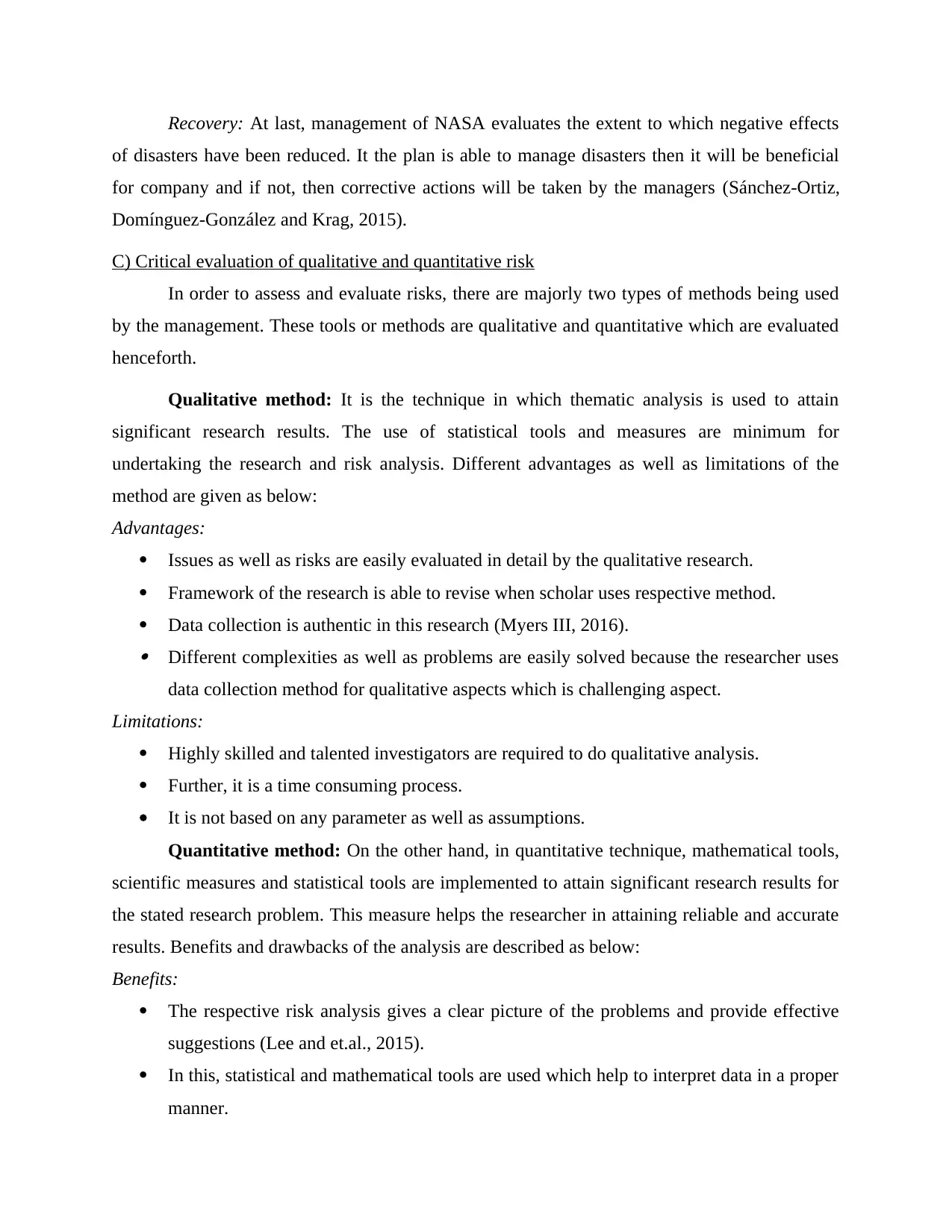
Recovery: At last, management of NASA evaluates the extent to which negative effects
of disasters have been reduced. It the plan is able to manage disasters then it will be beneficial
for company and if not, then corrective actions will be taken by the managers (Sánchez-Ortiz,
Domínguez-González and Krag, 2015).
C) Critical evaluation of qualitative and quantitative risk
In order to assess and evaluate risks, there are majorly two types of methods being used
by the management. These tools or methods are qualitative and quantitative which are evaluated
henceforth.
Qualitative method: It is the technique in which thematic analysis is used to attain
significant research results. The use of statistical tools and measures are minimum for
undertaking the research and risk analysis. Different advantages as well as limitations of the
method are given as below:
Advantages:
Issues as well as risks are easily evaluated in detail by the qualitative research.
Framework of the research is able to revise when scholar uses respective method.
Data collection is authentic in this research (Myers III, 2016). Different complexities as well as problems are easily solved because the researcher uses
data collection method for qualitative aspects which is challenging aspect.
Limitations:
Highly skilled and talented investigators are required to do qualitative analysis.
Further, it is a time consuming process.
It is not based on any parameter as well as assumptions.
Quantitative method: On the other hand, in quantitative technique, mathematical tools,
scientific measures and statistical tools are implemented to attain significant research results for
the stated research problem. This measure helps the researcher in attaining reliable and accurate
results. Benefits and drawbacks of the analysis are described as below:
Benefits:
The respective risk analysis gives a clear picture of the problems and provide effective
suggestions (Lee and et.al., 2015).
In this, statistical and mathematical tools are used which help to interpret data in a proper
manner.
of disasters have been reduced. It the plan is able to manage disasters then it will be beneficial
for company and if not, then corrective actions will be taken by the managers (Sánchez-Ortiz,
Domínguez-González and Krag, 2015).
C) Critical evaluation of qualitative and quantitative risk
In order to assess and evaluate risks, there are majorly two types of methods being used
by the management. These tools or methods are qualitative and quantitative which are evaluated
henceforth.
Qualitative method: It is the technique in which thematic analysis is used to attain
significant research results. The use of statistical tools and measures are minimum for
undertaking the research and risk analysis. Different advantages as well as limitations of the
method are given as below:
Advantages:
Issues as well as risks are easily evaluated in detail by the qualitative research.
Framework of the research is able to revise when scholar uses respective method.
Data collection is authentic in this research (Myers III, 2016). Different complexities as well as problems are easily solved because the researcher uses
data collection method for qualitative aspects which is challenging aspect.
Limitations:
Highly skilled and talented investigators are required to do qualitative analysis.
Further, it is a time consuming process.
It is not based on any parameter as well as assumptions.
Quantitative method: On the other hand, in quantitative technique, mathematical tools,
scientific measures and statistical tools are implemented to attain significant research results for
the stated research problem. This measure helps the researcher in attaining reliable and accurate
results. Benefits and drawbacks of the analysis are described as below:
Benefits:
The respective risk analysis gives a clear picture of the problems and provide effective
suggestions (Lee and et.al., 2015).
In this, statistical and mathematical tools are used which help to interpret data in a proper
manner.
Paraphrase This Document
Need a fresh take? Get an instant paraphrase of this document with our AI Paraphraser
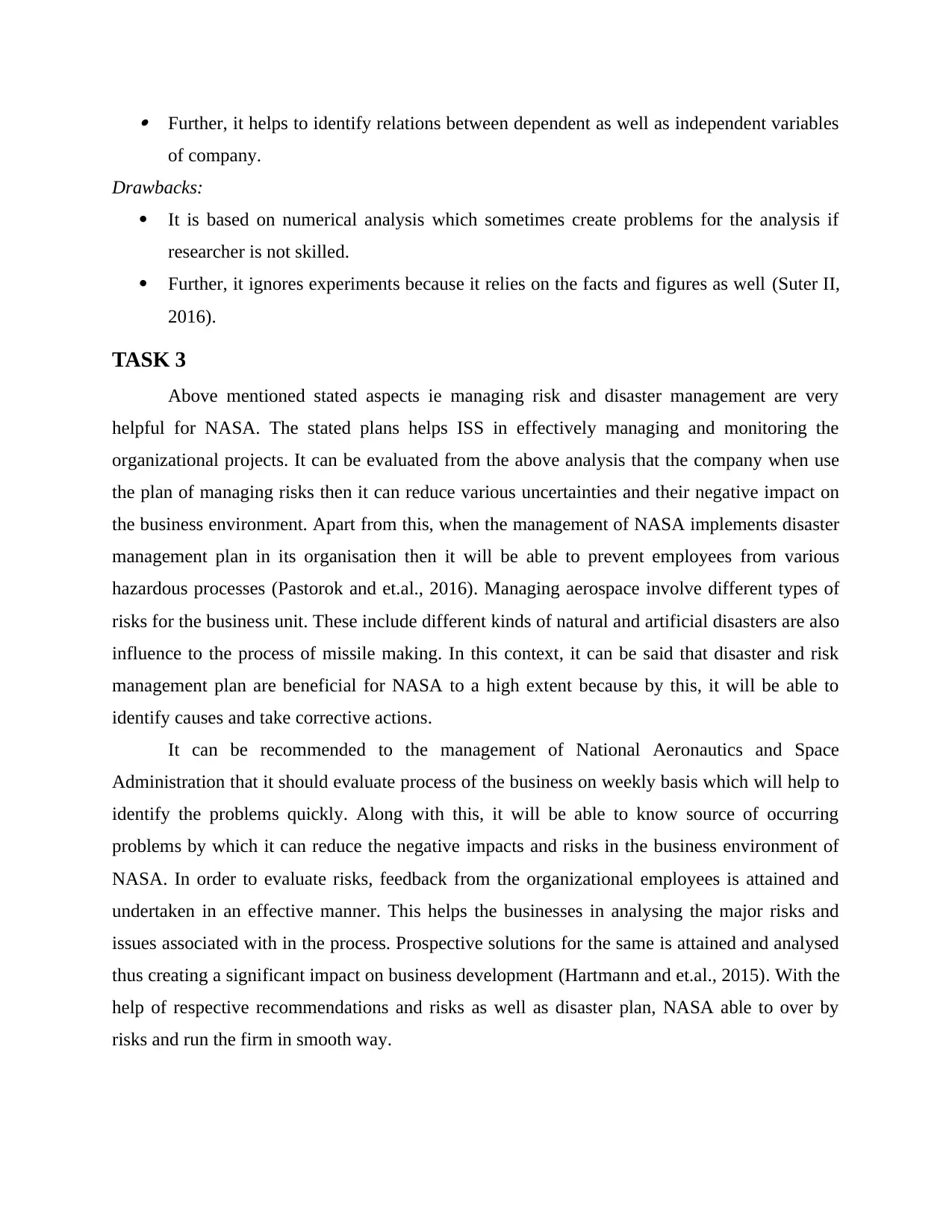
Further, it helps to identify relations between dependent as well as independent variables
of company.
Drawbacks:
It is based on numerical analysis which sometimes create problems for the analysis if
researcher is not skilled.
Further, it ignores experiments because it relies on the facts and figures as well (Suter II,
2016).
TASK 3
Above mentioned stated aspects ie managing risk and disaster management are very
helpful for NASA. The stated plans helps ISS in effectively managing and monitoring the
organizational projects. It can be evaluated from the above analysis that the company when use
the plan of managing risks then it can reduce various uncertainties and their negative impact on
the business environment. Apart from this, when the management of NASA implements disaster
management plan in its organisation then it will be able to prevent employees from various
hazardous processes (Pastorok and et.al., 2016). Managing aerospace involve different types of
risks for the business unit. These include different kinds of natural and artificial disasters are also
influence to the process of missile making. In this context, it can be said that disaster and risk
management plan are beneficial for NASA to a high extent because by this, it will be able to
identify causes and take corrective actions.
It can be recommended to the management of National Aeronautics and Space
Administration that it should evaluate process of the business on weekly basis which will help to
identify the problems quickly. Along with this, it will be able to know source of occurring
problems by which it can reduce the negative impacts and risks in the business environment of
NASA. In order to evaluate risks, feedback from the organizational employees is attained and
undertaken in an effective manner. This helps the businesses in analysing the major risks and
issues associated with in the process. Prospective solutions for the same is attained and analysed
thus creating a significant impact on business development (Hartmann and et.al., 2015). With the
help of respective recommendations and risks as well as disaster plan, NASA able to over by
risks and run the firm in smooth way.
of company.
Drawbacks:
It is based on numerical analysis which sometimes create problems for the analysis if
researcher is not skilled.
Further, it ignores experiments because it relies on the facts and figures as well (Suter II,
2016).
TASK 3
Above mentioned stated aspects ie managing risk and disaster management are very
helpful for NASA. The stated plans helps ISS in effectively managing and monitoring the
organizational projects. It can be evaluated from the above analysis that the company when use
the plan of managing risks then it can reduce various uncertainties and their negative impact on
the business environment. Apart from this, when the management of NASA implements disaster
management plan in its organisation then it will be able to prevent employees from various
hazardous processes (Pastorok and et.al., 2016). Managing aerospace involve different types of
risks for the business unit. These include different kinds of natural and artificial disasters are also
influence to the process of missile making. In this context, it can be said that disaster and risk
management plan are beneficial for NASA to a high extent because by this, it will be able to
identify causes and take corrective actions.
It can be recommended to the management of National Aeronautics and Space
Administration that it should evaluate process of the business on weekly basis which will help to
identify the problems quickly. Along with this, it will be able to know source of occurring
problems by which it can reduce the negative impacts and risks in the business environment of
NASA. In order to evaluate risks, feedback from the organizational employees is attained and
undertaken in an effective manner. This helps the businesses in analysing the major risks and
issues associated with in the process. Prospective solutions for the same is attained and analysed
thus creating a significant impact on business development (Hartmann and et.al., 2015). With the
help of respective recommendations and risks as well as disaster plan, NASA able to over by
risks and run the firm in smooth way.
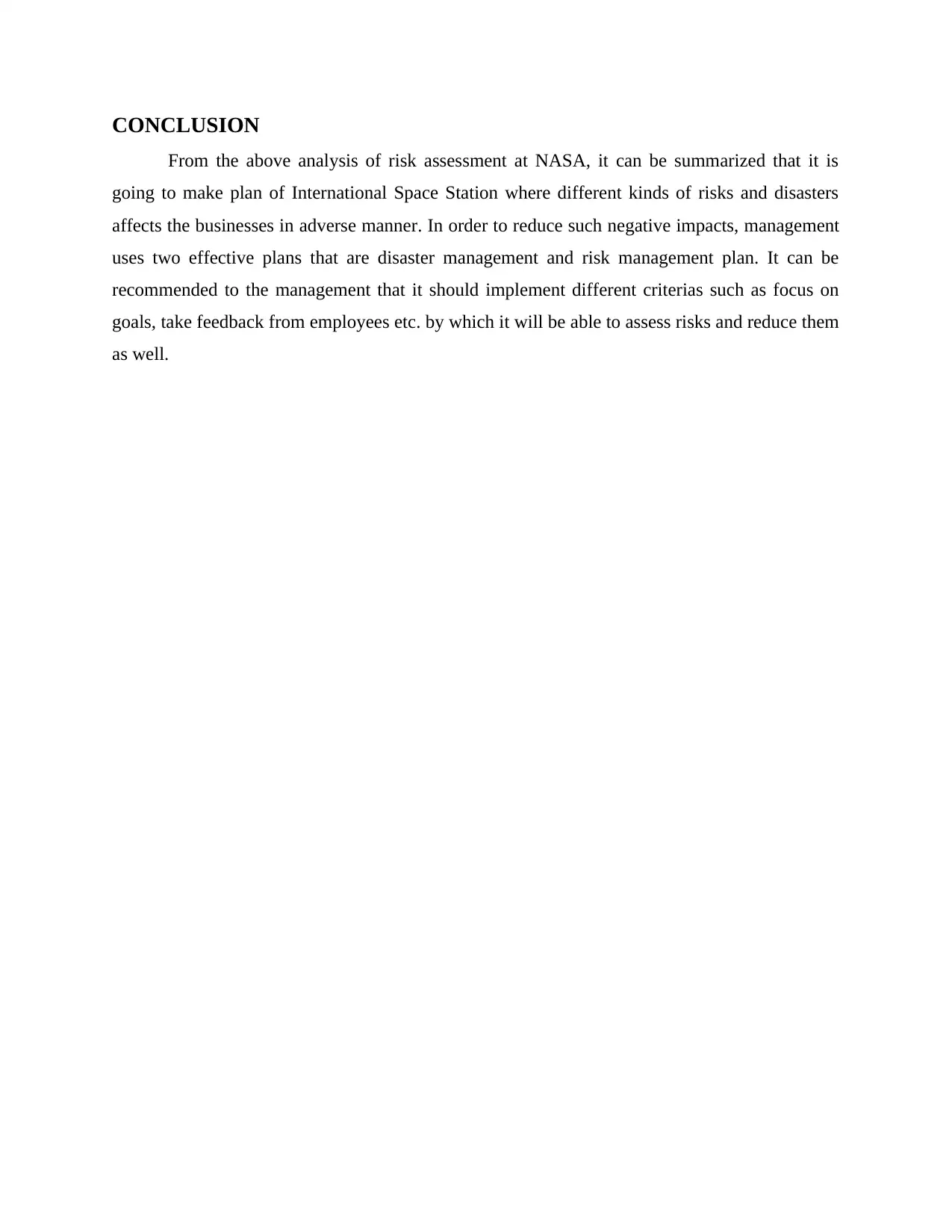
CONCLUSION
From the above analysis of risk assessment at NASA, it can be summarized that it is
going to make plan of International Space Station where different kinds of risks and disasters
affects the businesses in adverse manner. In order to reduce such negative impacts, management
uses two effective plans that are disaster management and risk management plan. It can be
recommended to the management that it should implement different criterias such as focus on
goals, take feedback from employees etc. by which it will be able to assess risks and reduce them
as well.
From the above analysis of risk assessment at NASA, it can be summarized that it is
going to make plan of International Space Station where different kinds of risks and disasters
affects the businesses in adverse manner. In order to reduce such negative impacts, management
uses two effective plans that are disaster management and risk management plan. It can be
recommended to the management that it should implement different criterias such as focus on
goals, take feedback from employees etc. by which it will be able to assess risks and reduce them
as well.
⊘ This is a preview!⊘
Do you want full access?
Subscribe today to unlock all pages.

Trusted by 1+ million students worldwide
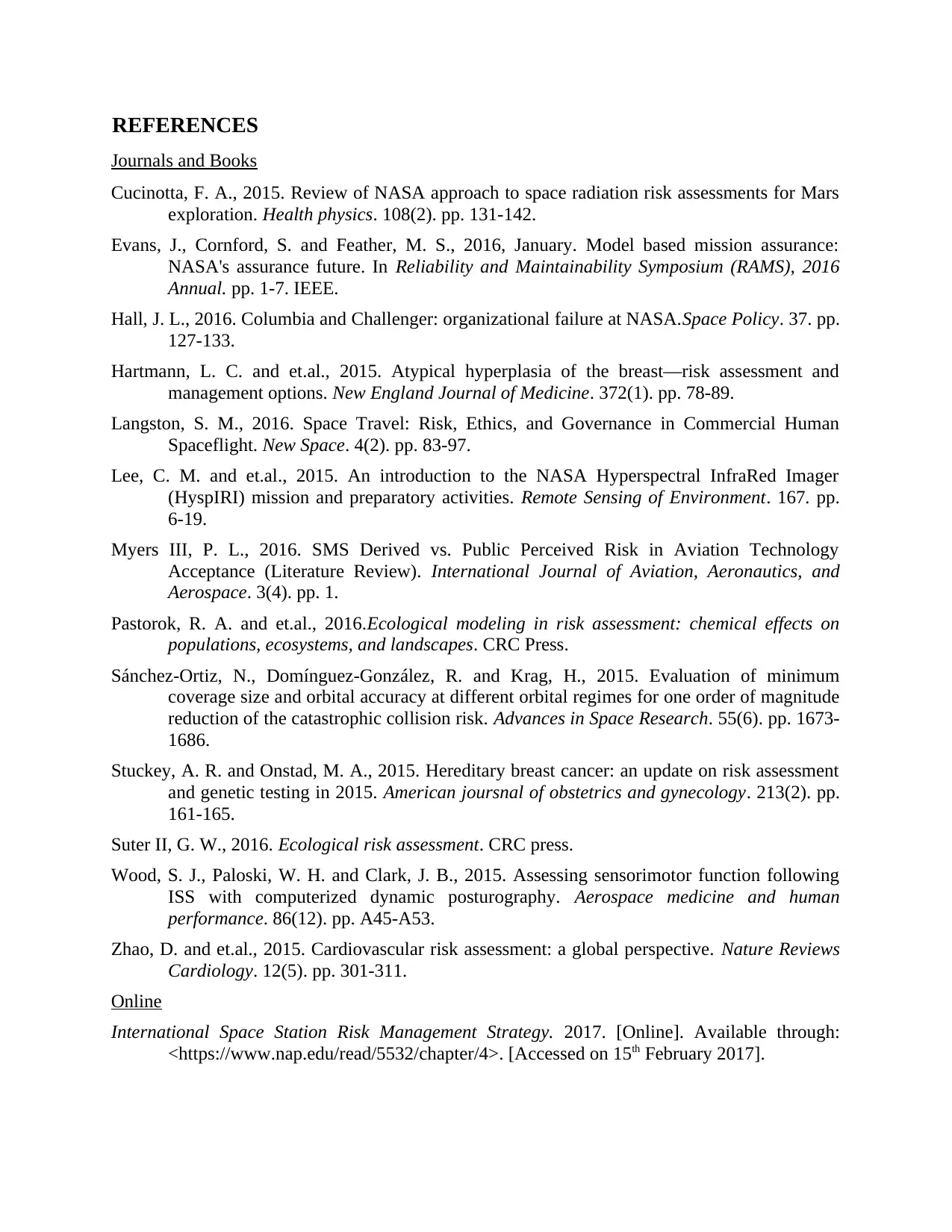
REFERENCES
Journals and Books
Cucinotta, F. A., 2015. Review of NASA approach to space radiation risk assessments for Mars
exploration. Health physics. 108(2). pp. 131-142.
Evans, J., Cornford, S. and Feather, M. S., 2016, January. Model based mission assurance:
NASA's assurance future. In Reliability and Maintainability Symposium (RAMS), 2016
Annual. pp. 1-7. IEEE.
Hall, J. L., 2016. Columbia and Challenger: organizational failure at NASA.Space Policy. 37. pp.
127-133.
Hartmann, L. C. and et.al., 2015. Atypical hyperplasia of the breast—risk assessment and
management options. New England Journal of Medicine. 372(1). pp. 78-89.
Langston, S. M., 2016. Space Travel: Risk, Ethics, and Governance in Commercial Human
Spaceflight. New Space. 4(2). pp. 83-97.
Lee, C. M. and et.al., 2015. An introduction to the NASA Hyperspectral InfraRed Imager
(HyspIRI) mission and preparatory activities. Remote Sensing of Environment. 167. pp.
6-19.
Myers III, P. L., 2016. SMS Derived vs. Public Perceived Risk in Aviation Technology
Acceptance (Literature Review). International Journal of Aviation, Aeronautics, and
Aerospace. 3(4). pp. 1.
Pastorok, R. A. and et.al., 2016.Ecological modeling in risk assessment: chemical effects on
populations, ecosystems, and landscapes. CRC Press.
Sánchez-Ortiz, N., Domínguez-González, R. and Krag, H., 2015. Evaluation of minimum
coverage size and orbital accuracy at different orbital regimes for one order of magnitude
reduction of the catastrophic collision risk. Advances in Space Research. 55(6). pp. 1673-
1686.
Stuckey, A. R. and Onstad, M. A., 2015. Hereditary breast cancer: an update on risk assessment
and genetic testing in 2015. American joursnal of obstetrics and gynecology. 213(2). pp.
161-165.
Suter II, G. W., 2016. Ecological risk assessment. CRC press.
Wood, S. J., Paloski, W. H. and Clark, J. B., 2015. Assessing sensorimotor function following
ISS with computerized dynamic posturography. Aerospace medicine and human
performance. 86(12). pp. A45-A53.
Zhao, D. and et.al., 2015. Cardiovascular risk assessment: a global perspective. Nature Reviews
Cardiology. 12(5). pp. 301-311.
Online
International Space Station Risk Management Strategy. 2017. [Online]. Available through:
<https://www.nap.edu/read/5532/chapter/4>. [Accessed on 15th February 2017].
Journals and Books
Cucinotta, F. A., 2015. Review of NASA approach to space radiation risk assessments for Mars
exploration. Health physics. 108(2). pp. 131-142.
Evans, J., Cornford, S. and Feather, M. S., 2016, January. Model based mission assurance:
NASA's assurance future. In Reliability and Maintainability Symposium (RAMS), 2016
Annual. pp. 1-7. IEEE.
Hall, J. L., 2016. Columbia and Challenger: organizational failure at NASA.Space Policy. 37. pp.
127-133.
Hartmann, L. C. and et.al., 2015. Atypical hyperplasia of the breast—risk assessment and
management options. New England Journal of Medicine. 372(1). pp. 78-89.
Langston, S. M., 2016. Space Travel: Risk, Ethics, and Governance in Commercial Human
Spaceflight. New Space. 4(2). pp. 83-97.
Lee, C. M. and et.al., 2015. An introduction to the NASA Hyperspectral InfraRed Imager
(HyspIRI) mission and preparatory activities. Remote Sensing of Environment. 167. pp.
6-19.
Myers III, P. L., 2016. SMS Derived vs. Public Perceived Risk in Aviation Technology
Acceptance (Literature Review). International Journal of Aviation, Aeronautics, and
Aerospace. 3(4). pp. 1.
Pastorok, R. A. and et.al., 2016.Ecological modeling in risk assessment: chemical effects on
populations, ecosystems, and landscapes. CRC Press.
Sánchez-Ortiz, N., Domínguez-González, R. and Krag, H., 2015. Evaluation of minimum
coverage size and orbital accuracy at different orbital regimes for one order of magnitude
reduction of the catastrophic collision risk. Advances in Space Research. 55(6). pp. 1673-
1686.
Stuckey, A. R. and Onstad, M. A., 2015. Hereditary breast cancer: an update on risk assessment
and genetic testing in 2015. American joursnal of obstetrics and gynecology. 213(2). pp.
161-165.
Suter II, G. W., 2016. Ecological risk assessment. CRC press.
Wood, S. J., Paloski, W. H. and Clark, J. B., 2015. Assessing sensorimotor function following
ISS with computerized dynamic posturography. Aerospace medicine and human
performance. 86(12). pp. A45-A53.
Zhao, D. and et.al., 2015. Cardiovascular risk assessment: a global perspective. Nature Reviews
Cardiology. 12(5). pp. 301-311.
Online
International Space Station Risk Management Strategy. 2017. [Online]. Available through:
<https://www.nap.edu/read/5532/chapter/4>. [Accessed on 15th February 2017].
Paraphrase This Document
Need a fresh take? Get an instant paraphrase of this document with our AI Paraphraser

What Does NASA Do?. 2015. [Online]. Available through:
<https://www.nasa.gov/about/highlights/what_does_nasa_do.html>. [Accessed on 15th
February 2017].
<https://www.nasa.gov/about/highlights/what_does_nasa_do.html>. [Accessed on 15th
February 2017].
1 out of 11
Related Documents
Your All-in-One AI-Powered Toolkit for Academic Success.
+13062052269
info@desklib.com
Available 24*7 on WhatsApp / Email
![[object Object]](/_next/static/media/star-bottom.7253800d.svg)
Unlock your academic potential
Copyright © 2020–2025 A2Z Services. All Rights Reserved. Developed and managed by ZUCOL.





